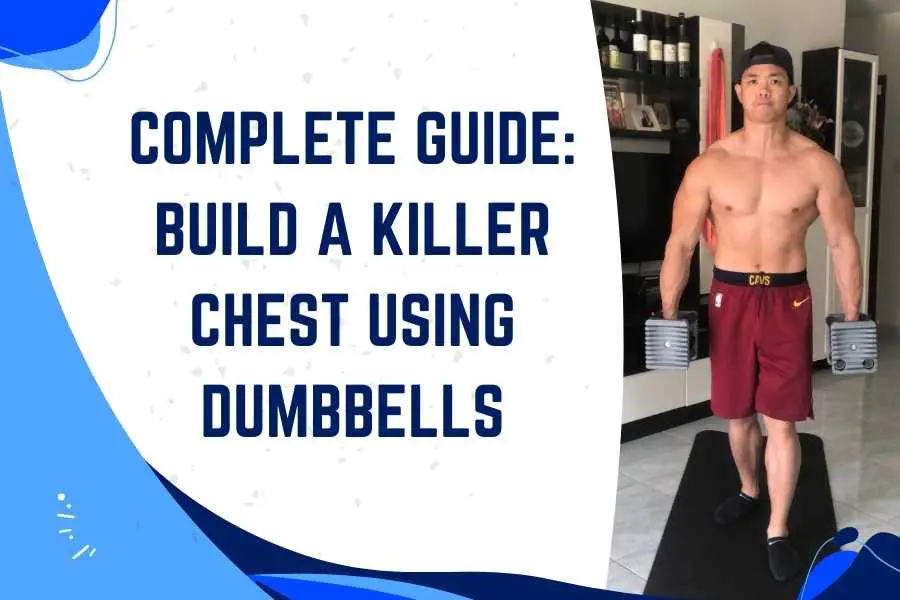If you’re looking to build an impressive chest, then dumbbells are an effective way to get there regardless of whether you are training at home or at the gym. This post explains how to get bigger pecs with dumbbells.
Key dumbbell exercises to increase chest size and strength include variations of the bench press and fly. Beginners are recommended to lift in the 8-12 rep range using a weight that is challenging. It is also important to eat enough calories and protein to fuel muscle growth.
Below, I share my favorite dumbbell exercises to target the inner, outer, upper, mid, and lower chest.
I’ll also reveal a full workout routine and 6 extra tips to grow your pecs fast.
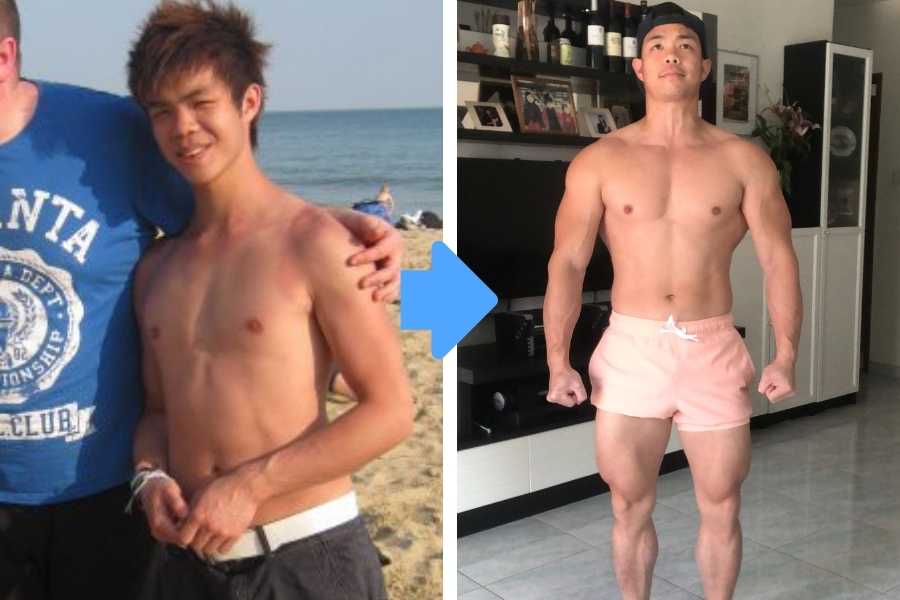
Key Points
- Most beginners can use dumbbells to build a bigger chest with or without a weight bench.
- It’s important to perform a variety of press and fly movements at different angles to hit the upper, mid, and lower pectorals.
- Use heavy dumbbells, lift with good form, and progressive overload for the fastest chest gains.
- Follow a bulking diet to fuel hypertrophy and strength gains.
7 Best Dumbbell Chest Exercises For Bigger Pecs
For many people, the pectorals are one of the hardest muscles to build. Dumbbell training is one of the most effective ways to target the pecs due to the wide range of motion, added instability, and different angles available to emphasize the upper, mid, and lower chest.
Here are 7 of the best dumbbell chest exercises you should include in your program to grow bigger pecs fast:
1) Flat Dumbbell Bench Press
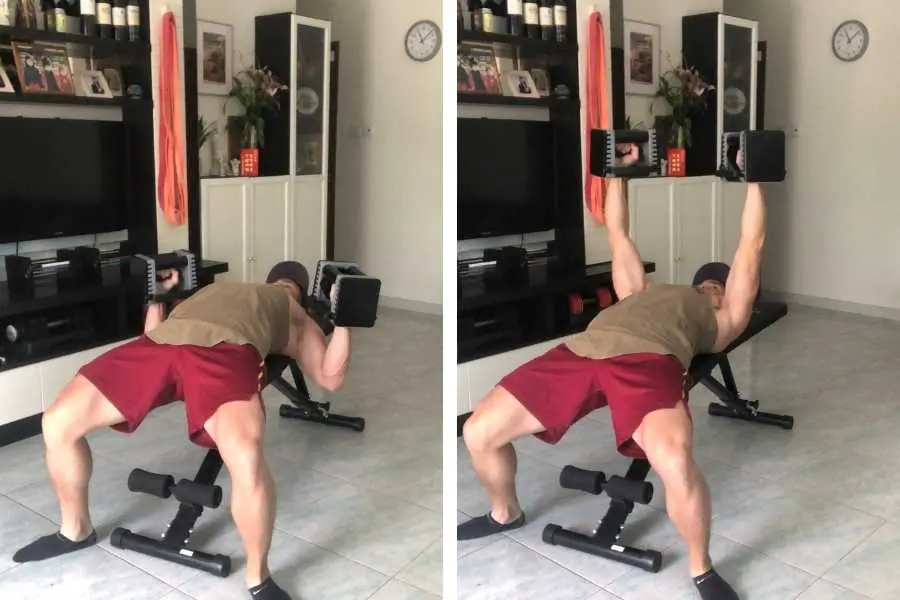
The flat bench press (also called the chest press) is considered by most lifters to be the king of pec-building exercises. And not including this exercise in your workout program is one of the most common reasons why a chest does not grow.
Whilst the bench press can be done with dumbbells or a barbell, Parker Hyde PhD (CSCS coach), and Bill Geiger (sports journalist) from Bodybuilding.com both advocate using dumbbells as the most effective way to train your pecs.
Here’s why:
- Unilateral loading. Dumbbells work the two sides of the chest independently. This can help correct strength imbalances, allow you to break strength plateaus faster, and lead to faster overall chest growth.
- Greater range of motion (ROM). Dumbbells allow your elbows to sink deeper at the bottom of the press and this gives a greater pectoral stretch. This 2020 study suggests a larger ROM increases muscle activation and facilitates hypertrophy (growth).
- Reduced stability. Dumbbells are inherently less stable than a barbell. More effort is required to stabilize them. And this gives your pecs a greater growth stimulus.
To gain the most chest growth benefits, you need to make sure you are dumbell pressing the correct weight.
How to do the flat dumbbell bench press:
- Start by laying on a flat weight bench with your mid-back slightly arched.
- Plant both feet firmly into the ground and ensure the bench supports your glutes and upper back.
- Hold two dumbbells up at shoulder level using an overhand grip.
- Inhale and keep it in to brace your torso and lower the dumbbells slowly towards your chest line.
- Keep your elbows slightly bent and tucked in towards your body throughout.
- Exhale and press the dumbbells back up to the starting position by straightening your arms.
2) Incline Dumbbell Bench Press
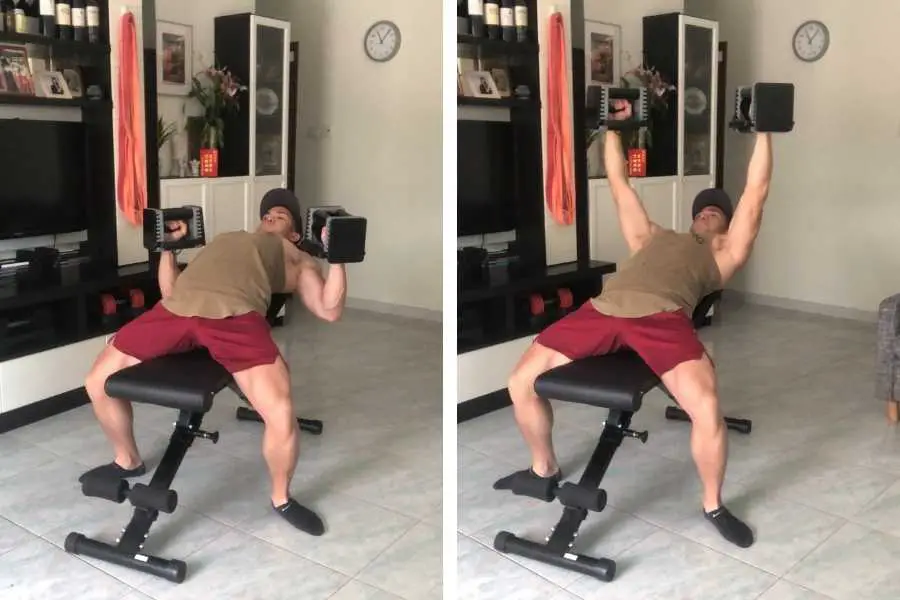
The pecs are large muscles with different regions that join onto different parts of the chest. These can be broadly categorized as the upper, mid, and lower pectorals.
Whilst the flat bench press is great for overall chest growth, it’s not ideal for targeting the upper pecs. And trust me, this is something you need to be doing if you want to grow a killer chest.
According to Andrew Heffernan (Openfit fitness coach), the incline bench press variation is your best option for emphasizing the upper chest.
This 2020 study showed that a 30° bench incline leads to the greatest upper pectoral activation.
Andrew also notes that most people find the incline press harder to perform compared to the flat variation. And the unstable nature of dumbbells further increases the difficulty. So don’t be afraid to reduce the weight by 10lbs per dumbbell if required.
How to do the incline dumbbell bench press:
- Set an adjustable weight bench to a 30-45° incline angle.
- Sit on the weight bench with your feet planted firmly on the floor.
- Grasp the dumbbells with a neutral-overhand grip (palms facing each other and opened slightly outwards).
- Rest the flat ends of both dumbbells on your thighs. Kick them upwards as you lay back on the bench.
- Press the dumbbells over your chest by extending your arms straight. This is your starting position.
- Inhale and lower the dumbbells to the chest line, keeping your elbows tucked towards the torso.
- Exhale and press the dumbbells back up to the starting position.
3) Decline Dumbbell Bench Press
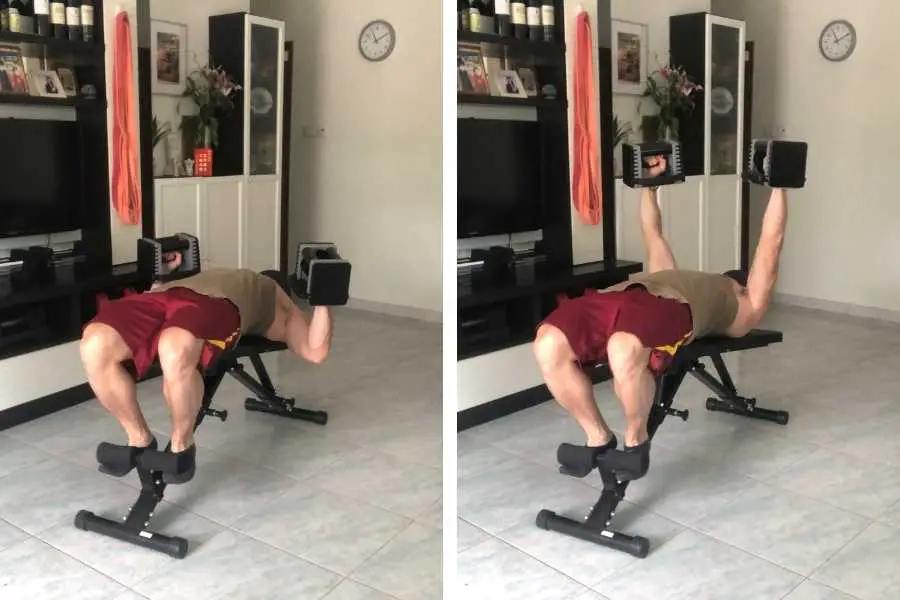
Many people disregard the decline bench press as an effective chest builder. The main argument is that the dumbbell flat bench press is enough to grow your pecs, and the decline variation is unnecessary.
But speaking from personal experience, the decline dumbbell bench press has its applications.
I find it to be a great exercise for pressing heavy loads. It’s also great for anyone who suffers from shoulder discomfort during the traditional flat bench press.
James Sadek (professional bodybuilder) claims that the decline dumbbell press is an undervalued movement that’s great for building the lower chest.
Not only is it effective for adding variety to your chest workouts, but it’s also good for developing a sharp cut definition at the bottom of your pecs that separates them from the abs
In support of James’s claim, this 1997 study found that decline pressing results in greater lower pectoral activation when compared to the flat and incline pressing.
How to do the decline dumbbell bench press:
- Set an adjustable weight bench to a -15-30° decline angle.
- Sit on the weight bench with your feet planted firmly on the foot anchor.
- Grasp 2 dumbbells with a neutral-overhand grip (palms facing each other and opened slightly outwards).
- Rest the flat ends of both dumbbells on your thighs. Kick them upwards as you lay back on the bench.
- Press the dumbbells over your chest by extending your arms straight. This is your starting position.
- Lower the dumbbells in a controlled motion towards your chest. Keep your elbows at a 45° to your torso.
- Stop when the dumbbells reach your chest line before pressing them back up.
4) Dumbbell Push-Ups
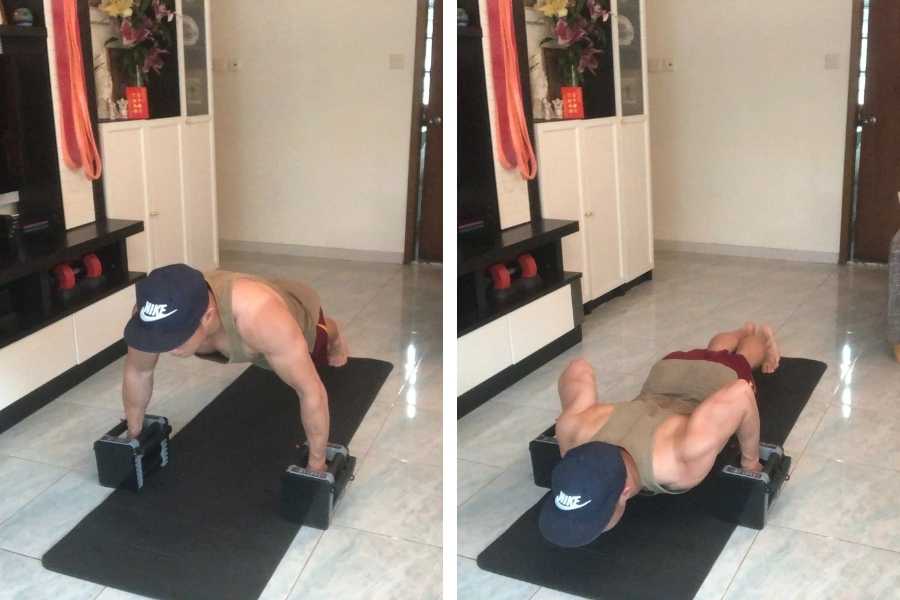
Push-ups on dumbbells are one of the best ways to build bigger pecs at home without a weight bench.
They are a versatile compound chest exercise that simultaneously works the pectorals (chest), deltoids (shoulders, and triceps (arms). It also engages the core and back for stability.
Here’s why it’s such a versatile exercise:
- Target different pectoral regions. Place your hands further apart to emphasize the outer pecs. Place your hands closer together to emphasize the inner pecs.
- Modifiable for different fitness levels. Beginners can start with dumbbell push-ups on the knees. Experienced lifters can do paused, tempo, or explosive reps for a challenge.
- Greater pectoral activation compared to regular press-ups. The dumbbells raise your torso and allow you to sink deeper at the bottom of the push-up, resulting in a greater pectoral stretch and activation.
How to do the dumbbell push-up:
- Place two flat-base dumbbells on the floor parallel to each other and to your body.
- Get into a press-up position with your hands holding the dumbbells instead of the floor.
- Keep your feet together, inhale, and expand your diaphragm to brace your core.
- Keep your elbows tucked into your body at 45° to your torso.
- Lower your chest by bending your elbows.
- Stop when your chest reaches the imaginary line passing through both dumbbell handles, before pressing yourself back up.
You can check out my other post for more information on how to include push-ups in your home bodyweight workout program to build muscle.
5) Flat Dumbbell Chest Fly
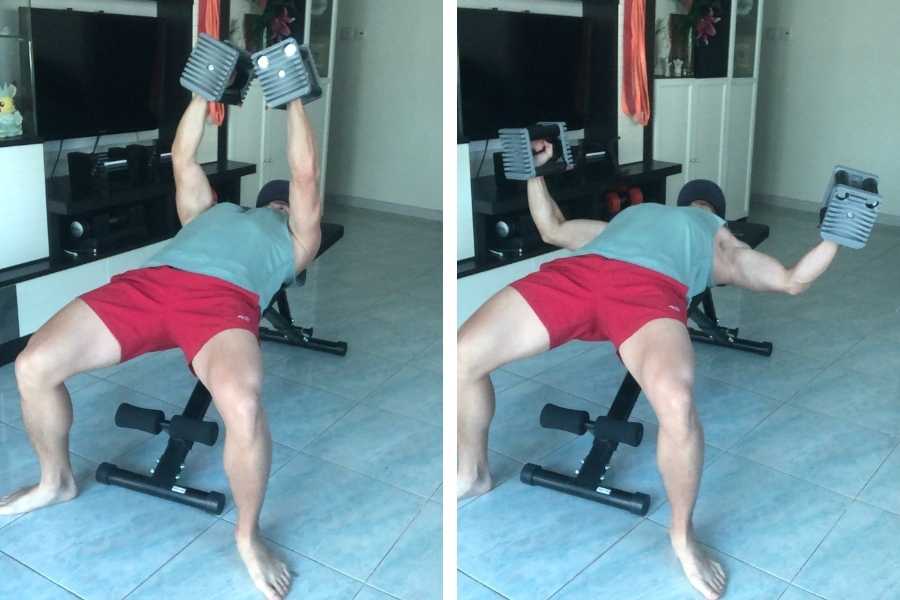
Dumbbell flies are a chest isolation-type movement that focuses tension specifically on the pectorals, unlike compound movements like the bench press which work multiple muscle groups.
This 2020 scientific study found that the bench press activates the pectorals more than the fly. However, this doesn’t make the dumbbell fly a redundant exercise.
Far from it; Chris Appleton (level 3 personal trainer at My Protein) notes that dumbbell flyes are actually great for isolating the inner pecs for a defined chest cleft.
Overall, I’d say the dumbbell fly is a great accessory movement to the bench press for building a big chest fast.
In other words, you should focus mainly on pressing. But you can also include 1-3 weekly sets of flyes to complement the press.
To gain the most hypertrophy benefits, make sure you use the right dumbbell fly weight.
How to do the flat dumbbell chest fly:
- Lay on a flat bench ensuring your head, shoulders, and glutes are all supported on the bench.
- Plant your feet firmly into the ground.
- Hold two dumbbells above your chest using a neutral grip (palms facing each other).
- Inhale to brace your core and slowly lower the dumbbells out to the sides, making sure to maintain a slight 140° bend at the elbows to reduce stress on your joints.
- Stop the movement when your upper arms are parallel to the ground (you should feel a pectoral stretch).
- Exhale and bring the weights back up to the starting position. Squeeze your chest muscles rather than lifting with your arms.
6) Dumbbell Floor Press
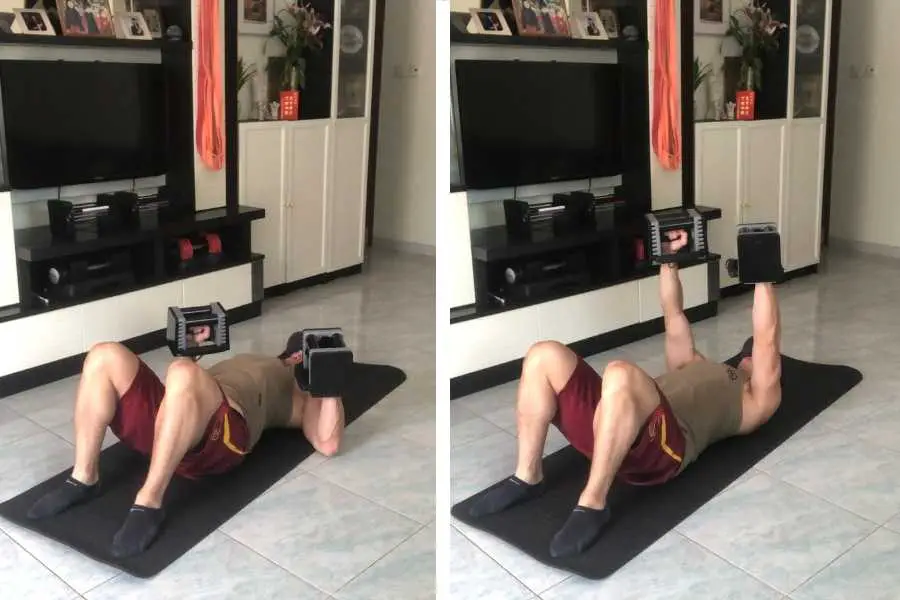
The dumbbell bench press can be performed without a bench; this variation is called the floor press. It’s a convenient exercise to build a bigger chest at home if you do not have a weight bench or gym membership.
Range of movement (ROM) is reduced, compared to the dumbbell bench press, since the floor prevents your elbows from dropping below the chest.
But the reduced ROM also brings benefits to beginners and those with shoulder joint issues.
Firstly, the reduced ROM allows you to target the chest, shoulders, and arms with minimal stress on the shoulder joint.
Secondly, it allows you to load up on heavier dumbbells. And this is great for building strength and confidence in the press.
How to do the dumbbell floor press:
- Lie on your back on an exercise mat, with your knees bent and. feet planted into the floor.
- Hold a dumbbell in each hand using a neutral-overhand grip (palms facing each other opened slightly outwards).
- Bring both dumbbells above your chest.
- Inhale and lower both dumbbells to the sides of your chest in a slow and controlled motion. Ensure your elbows are tucked towards your body at 45° to the torso and the dumbbells are stacked directly above your elbows.
- Stop the movement when your upper arm reaches parallel to the ground.
- Exhale and press the dumbbells back up to the starting position.
You may also be interested in my other post for gym bench substitutes you can use at home.
7) Standing Upward Dumbbell Fly
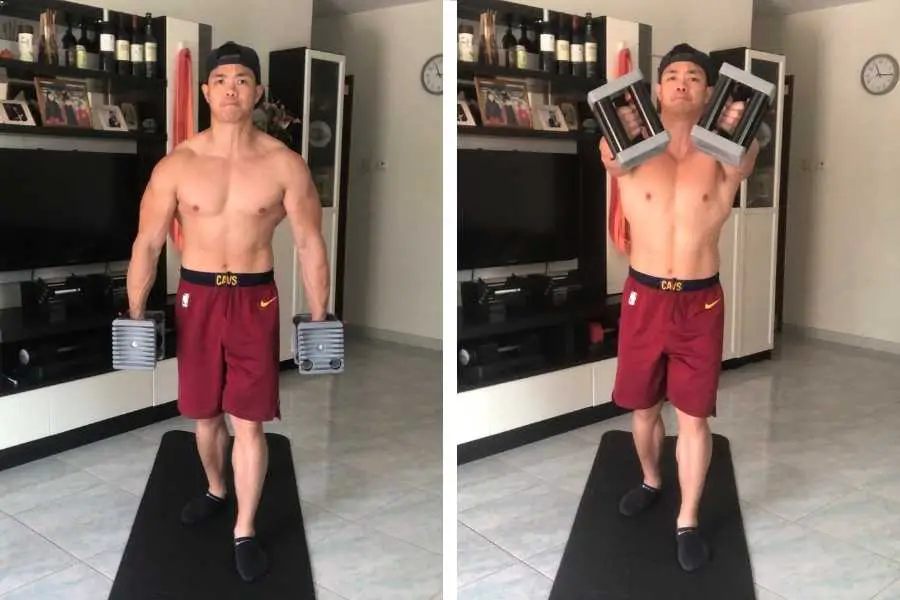
The standing upward fly is another no-bench dumbbell chest exercise that you can do to build bigger pecs at home.
It’s a good exercise to directly isolate your upper chest with nothing but a pair of light to moderate-weight dumbbells.
The upward fly also targets the anterior deltoids. And stronger deltoids will indirectly contribute to a stronger bench press.
As with all chest-isolation movements, I recommend including them in your workout program as accessories to your main compound pressing movements.
How to do the standing dumbbell upward fly:
- Stand with a staggered stance (one foot in front of the other) whilst holding a dumbbell in each hand using a neutral grip (palms facing each other).
- Bend slightly forward by 1-2 inches, keeping your back straight.
- Inhale and raise both dumbbells towards the opposite side of the body in a sweeping motion. Keep a slight bend at the elbows to minimize joint stress.
- Stop when both dumbbells meet.
- Pause for a split second before
- Exhale and slowly lower the dumbbells in a controlled motion.
Workout To Get Bigger Pecs With Dumbbells
Here’s a 30-minute workout you can perform at home without a bench or at the gym with a bench. Both workouts will help you to build bigger pecs with your dumbbells
Dumbbell chest workout without a weight bench:
| Exercise | Sets | Reps | Rest | Weight |
|---|---|---|---|---|
| Dumbbell floor press | 4 | 10 | 2 mins | 75% 1RM |
| Standing dumbbell upward fly | 4 | 12 | 2 mins | 70% 1RM |
| Dumbbell push-ups | 2 | AMRAP | 2 mins | Bodyweight |
How to do it:
Perform each exercise in the given order, completing the allotted sets and reps before moving on to the next exercise.
AMRAP stands for “as many reps as possible”. In other words, do push-ups to failure. This is a great finisher exercise to ensure maximum chest fatigue and growth by the end of your workout.
Rest for 2 minutes in between sets.
General recommended weights are given. But you may need to increase/decrease weight according to your personal strength level.
The ideal weight is heavy enough to challenge you for the allotted reps but light enough to lift with good form.
For more information, you can check out my post on choosing the ideal dumbbell weight to build muscle.
Dumbbell chest workout with a weight bench:
| Exercise | Sets | Reps | Rest | Weight |
|---|---|---|---|---|
| Flat dumbbell bench press | 3 | 8 | 2 mins | 80% 1RM |
| Incline dumbbell bench press | 3 | 8 | 2 mins | 80% 1RM |
| Flat dumbbell chest fly | 2 | 12 | 2 mins | 70% 1RM |
| Dumbbell push-ups | 1 | AMRAP | 2 mins | Bodyweight |
How to do it:
See “how to do it” notes for the dumbbell chest workout above.
You may also be interested in my dumbbell home workout for an alternative program that works the full body (including the chest) for a balanced physique.
6 Tips To Get Bigger Pecs With Dumbbells
If you’re following good training and nutrition practices, you should be able to build noticeably bigger pecs within 6 months.
Below, I share 6 tips that helped me build bigger pecs with dumbbells.
These tips are in line with 100 responses from this Reddit Poll which asked: “how to get bigger pecs”:
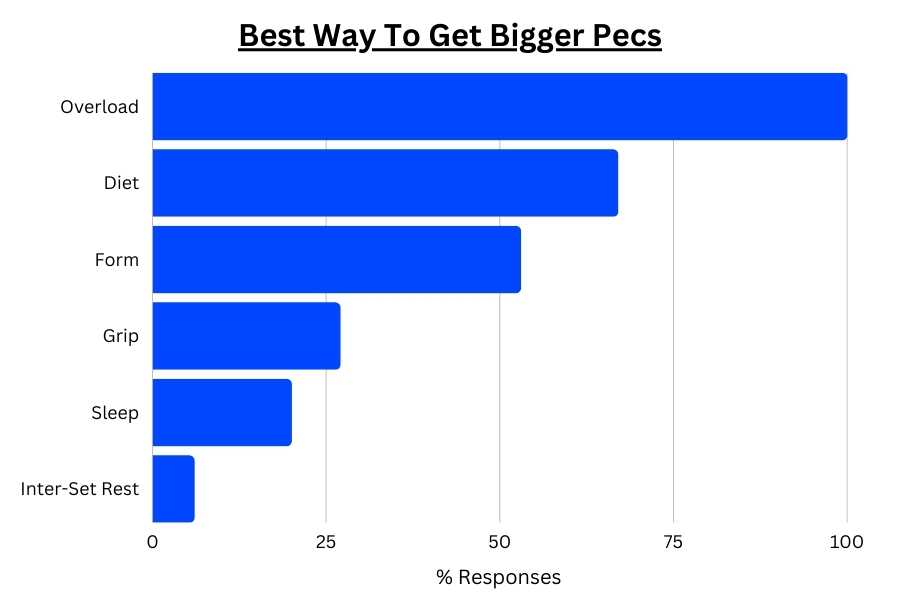
1) Progressive overload regularly
If you want to build a truly impressive chest with your dumbbell exercises, or even if you’re just looking to add some noticeable pectoral definition, you need to progressive overload.
Overloading describes increasing exercise intensity over time to keep your muscles challenged and growing. This is often achieved by:
- Lifting heavier weights.
- Increasing reps.
- Performing more workouts.
- Decreasing inter-set rest time.
Any of the above will work, but I recommend you only adopt one method at a time. Lifting progressively heavier dumbbells is the easiest option for most people.
An example overload routine for a dumbbell bench press:
| Week | Flat Bench Press Weight (Per Dumbbell) |
|---|---|
| 1 | 15kg (33lb) |
| 2 | 17.5kg (39lb) |
| 3 | 15kg (33lb) |
| 4 | 17.5kg (39lb) |
| 5 | 20kg (44lb) |
| 6 | 17.5kg (39lb) |
You can check out my other post for details on how to overload with dumbbells.
2) Consume A muscle-building diet
Training your pecs is just half the battle if you’re looking to build a big chest. Proper nutrition is equally important.
Without eating a calorie and protein surplus (also called “bulking”), your muscles won’t have the energy to get bigger and stronger.
The goal of bulking is to gain lean muscle and increase strength with minimal fat gains.
To do this, I recommend going on a mild caloric surplus of 5-15% more than your daily maintenance calories. In addition, aim for 1g of protein per lb of body weight.
You can check out my home bulking program for skinny guys.
3) Lift with proper form
It’s widely accepted that t build muscle, you need to lift heavy.
However, sacrificing form for heavy weights is not the best way to build a big chest fast.
You also need to lift with good form in order to fully engage your chest muscles. Good form practices vary between exercises.
Examples of good form cues for the dumbbell bench press include:
| Dumbbell Bench Press Technique: | Reason |
|---|---|
| Keep the scapula (shoulder blade) squeezed together throughout the exercise | Braces your core and ensures the movement primarily engages the pecs, rather than the arms and shoulders. |
| Arc the upper arm towards the face as you press the dumbbell up. | Promotes maximal engagement of the pecs rather than the triceps. |
| Keep your elbows at a 45° angle to the torso. | Relieves stress from your arms and shoulders (do not flare your elbows out). |
| Do not rotate the dumbbells more than necessary. | Relieves stress from the arms and shoulders. |
By choosing a weight that allows you to maintain proper form throughout the lift, you ensure your maximal pectoral activation and growth.
4) Widen your dumbbell grip
A common mistake made by beginners that can negatively impact chest growth is to press with too narrow a grip.
Widening your grip to 1.5-2x the width between your shoulders will transfer tension away from the shoulders and arms, and onto the pectorals.
As a beginner, I recommend you do this slowly because wide-grip pressing can feel awkward and uncomfortable if you’ve never done it before. Widen your grip by 1 inch every week.
This helps your shoulder joint to adapt to the widening process.
5) Ensure you get enough sleep
Sleep is when your body actively builds muscle. So in order to maximize pec growth from your dumbbell program, you need to get enough sleep.
In support of this, a 2011 study showed that sleep-deprived individuals have 60% less muscle mass while those who get adequate sleep have 40% more muscle mass.
Quality sleep is linked to a higher testosterone and IGF-1 response to training. Both are anabolic (muscle-building) hormones.
6) Get enough rest in between sets
It’s important to give your muscles adequate time to rest in between sets. Recommended rest times in workout programs should be treated as guidelines.
In reality, you should rest for however long is needed for you to feel ready for the next set. Generally speaking, most people need at least 60 seconds to fully recover between sets.
But as a newbie, don’t be afraid to rest up to 2-3 minutes or more.
Longer rest periods allow for you to complete a higher training volume since heavier weights can be lifted in a given set. And this is beneficial for chest hypertrophy.
Conclusion
Variations of the bench press and fly are the best exercises to get bigger pecs fast using dumbbells.
You can follow my workout routines (with or without a weight bench) to add some serious mass to your chest. These workouts can be done at home or at the gym.
Additionally, make sure you follow my 6 extra tips to ensure pectoral growth!
You may also be interested in the downloadable Kalibre Blueprint PDF which details exactly how I gained 40lbs of lean muscle (it’s 100% free!). It details the exact exercises and nutrition (with printables) I used to go from skinny to ripped!

